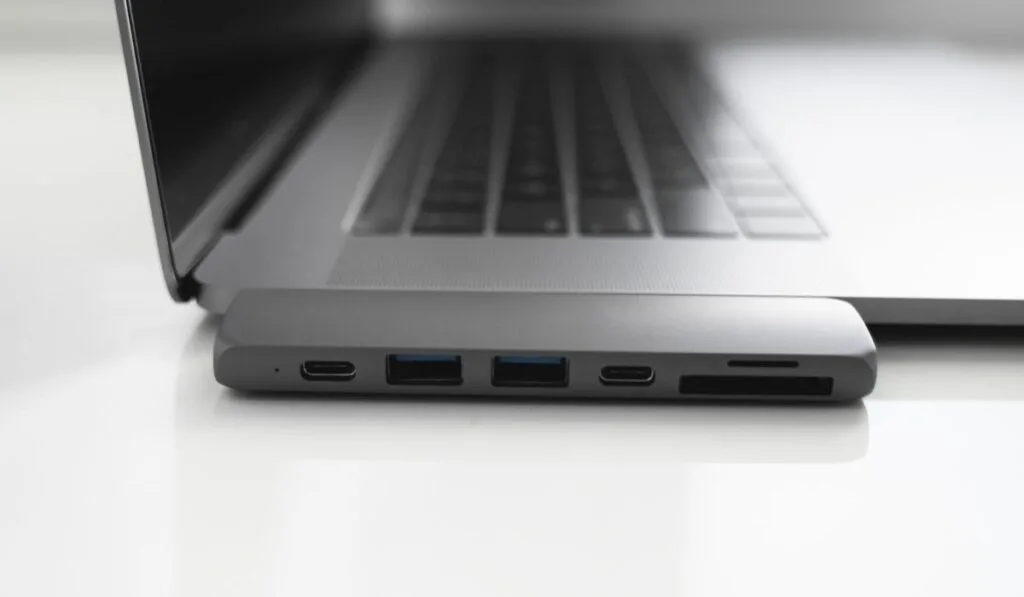While there are many USB2 to USB-C or HDMI to USB-C devices, it can be tricky to find a device that allows you to split a USB-C port into two, allowing you to connect multiple cables. So, how can you connect multiple USB-C cables (like an external display, an SSD, and a tablet) into one port?
You can use a splitter to connect multiple USB-C cables to one port for charging purposes, but only if they have the same charging requirements. In the case of external devices like SSDs and external monitors, it’s better to use a dedicated USB-C hub.
Let’s see what a USB-C cable is and how you can use splitters to connect more than one USB-C cable to a port. We’ll also examine whether it’s safe to use these splitters, if they have any drawbacks, and where you can get them.
What is a USB-C Cable?
The USB-C cable is the industry-standard wire that can transmit power and data on one cable. Its distinct rectangular shape with smooth, curved corners is easily recognizable. And since it’s completely symmetrical, there’s no wrong way to insert it.
It’s also relatively narrow and can fit your phones without a problem, making it a standard connector for phones, computers, and gaming consoles. For instance, devices like the Samsung Galaxy phones, the Nintendo Switch, and the MacBook Pro use USB-C.
In addition to transferring power and data, you can also send audio and video files over the USB-C. However, its speed depends on the device it’s connected to, but it’s generally much faster than other USB connectors.
By default, a USB-C cable connected to a USB 3.1 port can provide a transfer speed of 10 Gbps and 20 Gbps when connected to a USB 3.2 port.
Can You Connect Two USB-C Cables to One Port?

This depends on how you plan on connecting it. For example, you can’t wire two USB-C cables into one and then connect it to a port. Both devices will fight to communicate with the port when connected.
When a device is connected via USB, it negotiates the speed requirements by manipulating data lines. If both devices try to pull both data lines, the speed will be something that neither device expects.
And even if the speed is correctly negotiated, you’ll still face another issue: both devices only respond to one device class request.
How to Connect Two Cables
The only way to connect two cables or two devices in one port is by using a hub that allows each connected device to negotiate its connection. So if you need a USB 3.1 hub with USB-C ports on both ends, you’ll need a hub, and in the case of charging cables, you can use a splitter.
If you want to connect two devices, like an external SSD and an external monitor, you can’t use a splitter because a USB-C signal can’t be split.
Meanwhile, a hub splits a USB-C input into two or more USB-C ports (they might also include other ports like USB-A), but it may not support features like video or pass-through charging (charging a power bank that charges a device simultaneously).
Is it Safe to Use USB-C Splitters?

USB-C is known as a point-to-point cable, and splitting can be dangerous. This is why it’s generally better not to use splitters for charging, especially if you have two devices with two different power requirements.
Most devices use a signaling protocol to settle on the power characteristics that a charger will provide. So if a device or charger doesn’t support this protocol, the default is 5V regardless of the current the charger can provide. So if the device needs a current less than what the charger can supply, it’ll limit the current it draws.
So if you use two different devices with a splitter, the charger might agree with the device and charge it at a higher voltage. If the other device isn’t expecting this voltage, the excessive voltage could result in damage.
Plus, depending on the charger’s current rating and how much power each device demands, it might be faster to charge them sequentially instead of together.
How to Find UBS-C Splitters
You can find both USB-C splitters and hubs in your local electronic stores. If not, you can order them online from Amazon. Some highly-recommended products include the Belkin 4-port USB-C Mini Hub, Trust USB-C 4 ports hub, and the CalDigit TS3.
